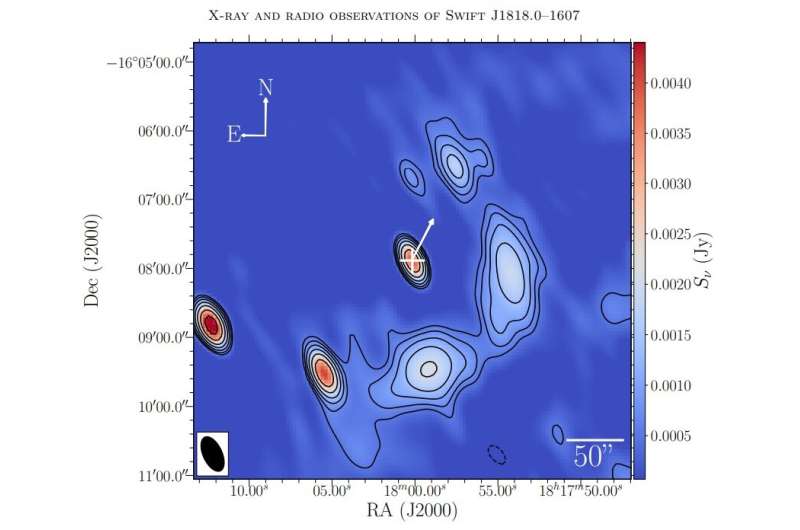December 7, 2022 report
Astronomers observe outburst of the young magnetar Swift J1818.0–1607

Using various space telescopes, European astronomers have performed deep X-ray and radio observations of a young magnetar known as Swift J1818.0–1607 during its outburst. Results of the observational campaign, published November 22 on arXiv.org, could help us better understand the nature of this source.
Magnetars are neutron stars with extremely strong magnetic fields, more than quadrillion times stronger than the magnetic field of our planet. Decay of magnetic fields in magnetars powers the emission of high-energy electromagnetic radiation, for instance, in the form of X-rays or radio waves.
Swift J1818.0–1607 was detected on March 12, 2020 during an outburst as a new X-ray source. Further observations found that this source is a fast-spinning magnetar with a spin period of approximately 1.36 seconds. Swift J1818.0–1607 has a characteristic age of about 265 years, dipolar surface magnetic field at the equator at a level of 340 trillion Gauss, and exhibits radio pulsations, hence the source was classified as a young radio-loud magnetar.
Recently, a team of astronomers led by Abubakr Ibrahim of the Autonomous University of Barcelona in Spain, has analyzed the data from the Swift, NuSTAR, XMM-Newton and INTEGRAL space telescopes, which started to monitor Swift J1818.0–1607 shortly after its outburst started.
"We report here on the long-term X-ray monitoring campaign of this young magnetar using XMM–Newton, NuSTAR, and Swift from the activation of its first outburst in March 2020 until October 2021, as well as INTEGRAL upper limits on its hard X-ray emission," the researchers wrote in the paper.
All in all, the X-ray monitoring campaign covered about 19 months of the outburst decay of Swift J1818.0–1607. This allowed the team to accurately characterize the behavior of the magnetar over a long time span.
The data show that the 0.3–10 keV luminosity of Swift J1818.0–1607 reached a peak value of approximately 90 decillion erg/s only a few minutes after the detection of the short burst on March 12, 2020 and decreased to about 3 decillion erg/s after 575 days. The total energy released in the outburst was estimated to be about one tredecillion ergs.
In general, the decay timescale and the released energy of the outburst of Swift J1818.0–1607 are in agreement with those derived by previous studies for magnetars showing major outbursts. The astronomers concluded that the decay pattern of this outburst is therefore similar to that observed for other magnetar outbursts.
The study detected the bright diffuse X-ray emission around the source extending between 50 and 110 arcseconds. Moreover, the researchers discovered the radio counterpart to Swift J1818.0–1607 and identified a half ring-like structure of bright diffuse radio emission, approximately 90 arcseconds to the west of the magnetar.
The authors of the paper assume that the diffuse X-ray emission is caused by a dust scattering halo and that the radio structure may be associated with a supernova remnant (SNR). However, further radio observations are planned to unveil the spectrum of this diffuse radio emission, and to confirm its SNR nature.
More information: A. Y. Ibrahim et al, Deep X-ray and radio observations of the first outburst of the young magnetar Swift J1818.0-1607, arXiv (2022). DOI: 10.48550/arxiv.2211.12391
Journal information: arXiv
© 2022 Science X Network





















